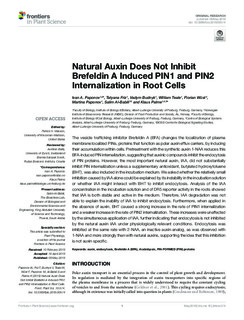| dc.contributor.author | Paponov, Ivan | |
| dc.contributor.author | Friz, Tatyana | |
| dc.contributor.author | Budnyk, Vadym | |
| dc.contributor.author | Teale, William | |
| dc.contributor.author | Wüst, Florian | |
| dc.contributor.author | Paponov, Martina | |
| dc.contributor.author | Al-Babili, Salim | |
| dc.contributor.author | Palme, Klaus | |
| dc.date.accessioned | 2020-02-17T12:52:49Z | |
| dc.date.available | 2020-02-17T12:52:49Z | |
| dc.date.created | 2020-01-13T14:52:39Z | |
| dc.date.issued | 2019-05-09 | |
| dc.identifier.issn | 1664-462X | |
| dc.identifier.uri | http://hdl.handle.net/11250/2641999 | |
| dc.description.abstract | The vesicle trafficking inhibitor Brefeldin A (BFA) changes the localization of plasma membrane localized PINs, proteins that function as polar auxin efflux carriers, by inducing their accumulation within cells. Pretreatment with the synthetic auxin 1-NAA reduces this BFA-induced PIN internalization, suggesting that auxinic compounds inhibit the endocytosis of PIN proteins. However, the most important natural auxin, IAA, did not substantially inhibit PIN internalization unless a supplementary antioxidant, butylated hydroxytoluene (BHT), was also included in the incubation medium. We asked whether the relatively small inhibition caused by IAA alone could be explained by its instability in the incubation solution or whether IAA might interact with BHT to inhibit endocytosis. Analysis of the IAA concentration in the incubation solution and of DR5 reporter activity in the roots showed that IAA is both stable and active in the medium. Therefore, IAA degradation was not able to explain the inability of IAA to inhibit endocytosis. Furthermore, when applied in the absence of auxin, BHT caused a strong increase in the rate of PIN1 internalization and a weaker increase in the rate of PIN2 internalization. These increases were unaffected by the simultaneous application of IAA, further indicating that endocytosis is not inhibited by the natural auxin IAA under physiologically relevant conditions. Endocytosis was inhibited at the same rate with 2-NAA, an inactive auxin analog, as was observed with 1-NAA and more strongly than with natural auxins, supporting the idea that this inhibition is not auxin specific. | nb_NO |
| dc.language.iso | eng | nb_NO |
| dc.rights | Navngivelse 4.0 Internasjonal | * |
| dc.rights.uri | http://creativecommons.org/licenses/by/4.0/deed.no | * |
| dc.subject | Auxin | nb_NO |
| dc.subject | Endocytosis | nb_NO |
| dc.subject | Brefeldin A (BFA) | nb_NO |
| dc.subject | Arabidopsis | nb_NO |
| dc.subject | PIN-FORMED (PIN) proteins | nb_NO |
| dc.title | Natural Auxin Does Not Inhibit Brefeldin A Induced PIN1 and PIN2 Internalization in Root Cells | nb_NO |
| dc.type | Journal article | nb_NO |
| dc.type | Peer reviewed | nb_NO |
| dc.description.version | publishedVersion | nb_NO |
| dc.rights.holder | © 2019 Paponov, Friz, Budnyk, Teale, Wüst, Paponov, Al-Babili and Palme. | nb_NO |
| dc.subject.nsi | VDP::Landbruks- og Fiskerifag: 900 | nb_NO |
| dc.source.volume | 10 | nb_NO |
| dc.source.journal | Frontiers in Plant Science | nb_NO |
| dc.identifier.doi | 10.3389/fpls.2019.00574 | |
| dc.identifier.cristin | 1771626 | |
| cristin.unitcode | 7677,1,0,0 | |
| cristin.unitname | Divisjon for matproduksjon og samfunn | |
| cristin.ispublished | true | |
| cristin.fulltext | original | |
| cristin.qualitycode | 2 | |

